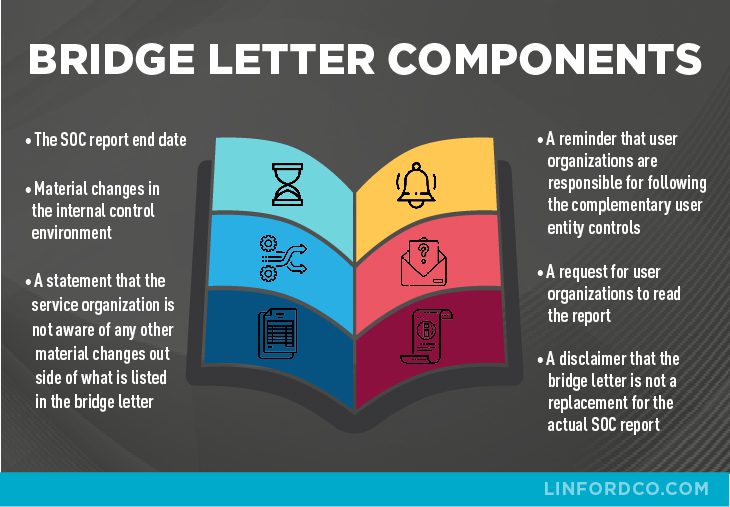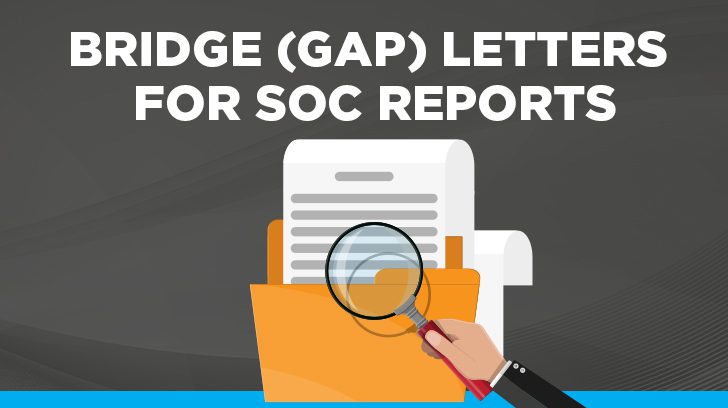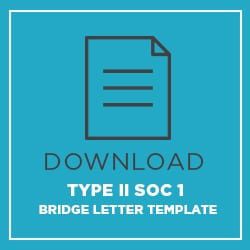Have you educated yourself on SOC reports but now find yourself wondering what a gap or bridge letter is and why it is relevant? A bridge letter, also referred to as a gap letter, is used to bridge the “gap” between the service organization’s SOC report date and the user entity’s year-end (i.e., calendar or fiscal year-end). In this post, we will cover common questions users have around gap or bridge letters as they relate to SOC reports (both SOC 1 and SOC 2), including further details on what bridge letters are, who provides them, how they are used, and their requirements.
What is the Purpose of a Bridge Letter?
SOC 1 and SOC 2 reports typically cover a period of 6 to 12 months and the SOC report period may not align with every user entity’s calendar or fiscal year. Meaning, the SOC report will often cover only a portion of a user entity’s calendar or fiscal year. For example, a report may have a period of October 1, 2020 through September 30, 2021. If a user entity has a calendar year-end (January 1, 2020 through December 31, 2021), the SOC report only provides coverage for 9 of 12 months in the period, leaving a 3-month gap in coverage. Common questions that we are asked in this situation are:
- If the user entity has a calendar year-end, what does the user entity do to gain comfort (e.g., an understanding) around the operating effectiveness of the internal control environment for the last three months of the year?
- Why aren’t all SOC reports issued to coincide with the calendar year-end?
There are various methods for a user entity to gain comfort around the operating effectiveness of the internal control environment for the remaining 3 months of the period and one of the most popular options is obtaining a bridge letter from the management of the service organization.
The timing of SOC report periods varies widely but they don’t typically coincide with calendar year-end because most user entities, especially their auditors, want the SOC reports while they are performing their interim internal control testing. This testing often occurs in the quarter prior to the user organization’s calendar or fiscal year-end. For example, if a user entity has a calendar year-end of December 31, the interim internal control testing will be performed sometime during the 3rd and/or 4th calendar quarter.

What is a Bridge Letter?
In the scenario noted above, the service organization has a gap in its report coverage, which is defined as the period between the report end date and the end of the user entity’s calendar year. In which case, the user entity may request a bridge letter from the service organization. A bridge letter can be used to cover the gap period in order to provide user entities with additional information and confidence in the service organization’s compliance position.
A bridge letter—also known as a gap letter—is simply a letter that bridges the “gap” between the service organization’s report date and the user entity’s year-end (i.e., calendar or fiscal year-end). This letter is a great tool that can be used by service organizations instead of making their clients (i.e., user entities) wait for the next SOC report they issue, which might require them to wait another 12 months. This letter is on the service organization’s letterhead and signed by the service organization, not the service auditor that performed the SOC examination.
Who Provides a Bridge Letter?
Since the service auditor is not signing the bridge letter, they are not attesting to the design or operating effectiveness of the internal controls within the gap period. Once the service auditors have issued the SOC report, the service auditors do not know definitively if the internal control environment has materially changed or not. This is because the service auditors have not performed any additional control testing between the end of the report period and the user organization’s year-end. However, the service organization’s management knows if there have been any changes in the control environment and if internal controls are still operating effectively, which they capture in the bridge letter. Management of the service organization is responsible for writing and providing user entities a bridge letter upon request.

Bridge Letter Components
There are several key components that management should address in a bridge letter, including the following:
- The SOC report period covered
- Material changes in the internal control environment (if any)
- A statement that the service organization is not aware of any other material changes outside of what is listed in the bridge letter (if any)
- A reminder that user organizations are responsible for following the complementary user entity controls—sometimes referred to as client control considerations or user control considerations
- A request for user organizations to read the report
- A disclaimer that the bridge letter is not a replacement for the actual SOC report
The list above includes suggested components that will provide users of the bridge letter with sufficient information to gain some comfort around the compliance of the service organization during the gap period. The AICPA doesn’t actually cover bridge letter requirements in the SOC guidance so there is no guidance on the specific requirements for a bridge letter but the list above provides a good place to start.

What Length of Time Can a Bridge Letter Cover?
You may be wondering, how long of a period can a bridge letter cover? The answer to this question really depends on the user of the report. A bridge letter’s purpose is to cover a limited amount of time between the report end date and the user entity’s year-end.
Keeping this in mind, most bridge letters typically cover a period of no more than three months. SOC examinations are meant to recur on at least an annual basis, in order to provide user entities with continuous coverage.
If service organizations are finding that the report period for their SOC examination is not meeting their users’ requirements from a timing standpoint, it may be worth the service organization revisiting the examination period with the service auditor rather than issuing a bridge letter for a period over 3 months.
SOC 1 Bridge Letter Template
We have seen both extremely complex bridge letters and ones that are so simple that they do not meet the requirements of user entities. If service organizations are unsure of what to include in their bridge letter or what it should look like, they should consult their service auditor.
Additionally, to aid service organizations, we have put together a couple of bridge letter example templates for a Type II SOC 1 report that covers all of the key points in a bridge letter and should meet the requirements of discerning user entities.
Bridge Letter Limitations
Bridge letters are helpful tools to service organizations in showing compliance throughout a user entity’s calendar or fiscal year, but they have limitations. Bridge letters are not a replacement for the actual SOC report. SOC examinations are meant to recur on at least an annual basis and bridge letters typically cover no more than 3 months. Bridge letters do not include the details included in the actual report such as the system description, test procedures, and test results. The user entity needs to review the SOC report, in addition to obtaining a bridge letter, in order to monitor the systems or services provided by the service organization and gain comfort around service commitments and system requirements being met throughout the period.
Summary
In this post we have discussed that a bridge letter (also referred to as a gap letter) is used to obtain coverage over the gap between the SOC report end date and the user entity’s year-end. Additionally, bridge letters are signed by the service organization’s management and typically cover no more than 3 months. Within a bridge letter, management is stating if there have been any material changes in the control environment since the end date of the SOC reporting period. Bridge letters are not meant to take the place of a SOC report but rather provide some form of coverage over the gap period. Lastly, we have provided users with a couple of example bridge letter templates to aid in their understanding of what a bridge letter should look like.
For any additional inquiries on bridge letters, SOC 1 audits or SOC 2 audits, or inquiries on how Linford & Company LLP can assist your organization, please contact us.
This article was originally published in 2015 and was updated on 2/15/2022. It has been updated several times over the years to reflect the most current information.

Megan Kovash specializes in SOC audits with experience in financial audit, internal audit, and data analytics as well. Megan started her career in 2012 after completing her Masters of Accountancy with the University of Denver. She is a CPA that specializes in IT security audits and started her career at Ernst & Young in Denver, then moved to the Internal Audit Data Analytics group at Charles Schwab. She started with Linford & Co., LLP in 2019 and is a partner with the firm. Megan enjoys working with clients to find and implement solutions that better her client’s business while also meeting audit requirements.






